Edvard Munch
"Life shakes the hand of death at the moment of conception."
(1863-1944)
Father of Expressionism
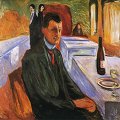 The Norwegian
artist Edvard Munch is regarded as a pioneer in
the Expressionist movement in modern painting. At an early stage Munch
was recognized in Germany and central Europe as one of the creators of
a new epoch. His star is still on the ascendant in the other European
countries, and in the rest of the world. Munch's art from the 1890s is
the most well known, but his later work is steadily attracting greater
attention, and it appears to inspire present-day artists in
particular.
The Norwegian
artist Edvard Munch is regarded as a pioneer in
the Expressionist movement in modern painting. At an early stage Munch
was recognized in Germany and central Europe as one of the creators of
a new epoch. His star is still on the ascendant in the other European
countries, and in the rest of the world. Munch's art from the 1890s is
the most well known, but his later work is steadily attracting greater
attention, and it appears to inspire present-day artists in
particular.
Edvard Munch grew up in Norway's capital, Oslo, then called Christiania. His father, Christian Munch - brother of the well-known historian P. A. Munch - was a deeply religious military doctor earning a modest income. His wife, who was 20 years his junior, died of tuberculosis when Edvard was only five years old, and Edvard's older sister, Sophie, died of the disease at the age of 15. Edvard himself was often ill. A younger sister was diagnosed with mental illness at an early age. Of the five siblings only one, Andreas, ever married, only to die a few months after the wedding.
His childhood home was culturally stimulating, but in his art Munch turned again and again to the memory of illness, death and grief.
Realism
After a year at Technical School, Munch became dedicated to art. He studied the old masters, attended courses in the painting of nudes at the Royal School of Drawing and was instructed for a time by Norway's leading artist, Christian Krohg. His early works were influenced by French-inspired Realism, and his great talent was soon discovered.
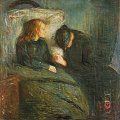 In 1885 Munch went on a short
study tour to Paris. That year he started on the work that was to be
his breakthrough, "The Sick Child", in which he makes a radical break
with the realistic approach seen in a similar motif by Christian
Krohg. Munch's picture was about his sister Sophie. He struggled with
the motif a long time, searching for "the first impression" and a
valid painterly expression for a painful, personal experience. He had
renounced perspective and plastic form, and had attained a composition
formula reminiscent of icons. The course texture of the surface
displayed all the signs of a laborious creative process. The criticism
was very negative.
In 1885 Munch went on a short
study tour to Paris. That year he started on the work that was to be
his breakthrough, "The Sick Child", in which he makes a radical break
with the realistic approach seen in a similar motif by Christian
Krohg. Munch's picture was about his sister Sophie. He struggled with
the motif a long time, searching for "the first impression" and a
valid painterly expression for a painful, personal experience. He had
renounced perspective and plastic form, and had attained a composition
formula reminiscent of icons. The course texture of the surface
displayed all the signs of a laborious creative process. The criticism
was very negative.
His main works from subsequent years are less provocative in their form. "Inger on the Beach" from 1889 shows Munch's ability to portray a lyrical atmosphere, in keeping with the new romantic trend of that time. The picture is painted in Asgardstrand, a small coastal town near Horten. It is this region's characteristic coastline we find used as a meaningful "leitmotif" in so many of Munch's compositions.
Kristiania bohemian
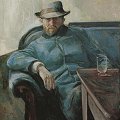 In 1889 he painted a
portrait of the leader of the Kristiania (as Christiania was now
spelled) bohemians, Hans Jaeger. Munch's association with Jaeger and
his circle of radical anarchists became a crucial turning point in his
life and a source of new inner unrest and conflict. At that time Munch
commenced an extensive biographical literary production which he
resumed at different periods in his life. These early writings serve
as a reference for several of the central motifs of the 'nineties. In
keeping with Jaeger's ideas he wanted to present truthful close-ups of
the modern individual's longings and agonies - he wanted to paint his
own life.
In 1889 he painted a
portrait of the leader of the Kristiania (as Christiania was now
spelled) bohemians, Hans Jaeger. Munch's association with Jaeger and
his circle of radical anarchists became a crucial turning point in his
life and a source of new inner unrest and conflict. At that time Munch
commenced an extensive biographical literary production which he
resumed at different periods in his life. These early writings serve
as a reference for several of the central motifs of the 'nineties. In
keeping with Jaeger's ideas he wanted to present truthful close-ups of
the modern individual's longings and agonies - he wanted to paint his
own life.
The years in France
In the autumn of 1889 Munch held a large separate exhibition in Kristiania, and was thereafter awarded a state travel grant for three consecutive years. Naturally, he went to Paris, where for a short time he was a pupil of Leon Bonnat, but he became more inspired by acquainting himself with the city's art life. At that time a Post-Impressionist breakthrough was in progress along with different anti-naturalist experiments. This had a liberating effect on Munch. "The camera cannot compete with a brush and canvas," he wrote, "as long as it can't be used in heaven and hell."
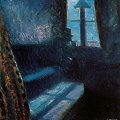 The first autumn, shortly
after Munch arrived in France, he was informed that his father had
died. The loneliness and melancholy in the painting "Night" (1890) are
often seen with this in mind. The dark interior with the lonely figure
at the window is completely dominated by tones of blue - a painting of
nuances which may be reminiscent of James McNeill Whistler's nocturnal
colour harmonies. This modern and independent work is also an
expression of the "decadence" in the final decade of the century.
The first autumn, shortly
after Munch arrived in France, he was informed that his father had
died. The loneliness and melancholy in the painting "Night" (1890) are
often seen with this in mind. The dark interior with the lonely figure
at the window is completely dominated by tones of blue - a painting of
nuances which may be reminiscent of James McNeill Whistler's nocturnal
colour harmonies. This modern and independent work is also an
expression of the "decadence" in the final decade of the century.
At the Autumn Exhibition in Kristiania in 1891 Munch showed among other works "Melancholy." Great curved lines and more homogeneous colour surfaces dominate here; there is a simplifying and formalizing of the motif similar to that found in French Synthetism. "Symbolism - nature is formed by one's state of mind," wrote Munch.
At this time Munch did the first sketches of the well-known "The Scream." He also painted several pictures in an Impressionist style verging on pointillism, with motifs from the Seine and from Kristiania's promenade, Karl Johan. However, it is the impressions of the soul, and not the eye, that are Munch's main interest.
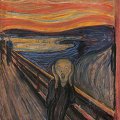 "The Scream" is often described as the first
expressionistic picture, and is the most extreme example of Munch's
"soul paintings." The facial expression depends to a large degree on
the painting's dynamics, the colours and lines. The scene - and
particularly the foreground figure - are grotesquely distorted and
rendered in colours that are not taken from external reality. Coming
as it does from Munch's own "inner hell", the painting visualizes a
desperate aspect of fin-de-siecle: anxiety and apocalypse. The
percussiveness of the motif shows that it also speaks to our day and
age.
"The Scream" is often described as the first
expressionistic picture, and is the most extreme example of Munch's
"soul paintings." The facial expression depends to a large degree on
the painting's dynamics, the colours and lines. The scene - and
particularly the foreground figure - are grotesquely distorted and
rendered in colours that are not taken from external reality. Coming
as it does from Munch's own "inner hell", the painting visualizes a
desperate aspect of fin-de-siecle: anxiety and apocalypse. The
percussiveness of the motif shows that it also speaks to our day and
age.
Berlin
In the autumn of 1892 Munch gave a broad presentation of his art, in which he included the fruits of his sojourn in France. This exhibition resulted in Munch being invited to show the same paintings to the Artist's Association of Berlin. It was a formidable "succes de scandale." The general public and the older painters interpreted Munch's art as anarchistic provocation, and the exhibition was closed in protest.
Because of that, Munch had made a name for himself in Berlin and he decided to stay there. He entered a circle of literati, artists and intellectuals, including a strong element of Scandinavians. The circle numbered among others the Norwegian sculptor Gustav Vigeland, the Danish writer Holger Drachman, the Polish poet Stanislaw Przybyszewski and the German art historian Julius Meier-Graefe. Of most importance to Munch was the meeting with Swedish dramatist August Strindberg. They discussed the philosophy of Nietzsche, occultism, psychology and the dark sides of sexuality.
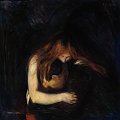 In December 1893 Munch had an exhibition at Unter den
Linden where he showed, among other things, six paintings entitled
"Study for a Series: Love." This was the beginning of a cycle he would
later call the "Frieze of Life - A Poem about Life, Love and Death."
It includes motifs that are steeped in atmosphere such as "The Storm",
"Moonlight" and "Starry Night", where one dimly perceives the
influence of Arnold Bocklin. Other motifs illuminate the nocturnal
side of love, such as "Rose and Amelie" and "Vampire."
In December 1893 Munch had an exhibition at Unter den
Linden where he showed, among other things, six paintings entitled
"Study for a Series: Love." This was the beginning of a cycle he would
later call the "Frieze of Life - A Poem about Life, Love and Death."
It includes motifs that are steeped in atmosphere such as "The Storm",
"Moonlight" and "Starry Night", where one dimly perceives the
influence of Arnold Bocklin. Other motifs illuminate the nocturnal
side of love, such as "Rose and Amelie" and "Vampire."
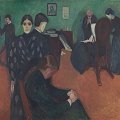 Several pictures have
death as a theme: "Death in the Sickroom" (1893) created quite a stir.
In this composition Munch's debt to the French Synthetists and
Symbolists is obvious. Painted in garish and pallid colours, the
picture shows a scene frozen fast like the tragic final tableau in a
drama. The motif is based on the memory of his sister Sophie's death,
and the whole family is represented. The dramatic focus in the picture
is on the figure who represents Munch himself. The following year the
"Frieze of Life" was enlarged by motifs such as "Anxiety", "Ashes",
"Madonna" and "Women in Three Stages", the latter a monumental motif
completely in keeping with the spirit of Symbolism.
Several pictures have
death as a theme: "Death in the Sickroom" (1893) created quite a stir.
In this composition Munch's debt to the French Synthetists and
Symbolists is obvious. Painted in garish and pallid colours, the
picture shows a scene frozen fast like the tragic final tableau in a
drama. The motif is based on the memory of his sister Sophie's death,
and the whole family is represented. The dramatic focus in the picture
is on the figure who represents Munch himself. The following year the
"Frieze of Life" was enlarged by motifs such as "Anxiety", "Ashes",
"Madonna" and "Women in Three Stages", the latter a monumental motif
completely in keeping with the spirit of Symbolism.
Together with Meier-Graefe and others, Przybyszewski published in 1894 the first publication about Munch's art, which he characterizes as "psychological realism."
Back to Berlin
In the spring of 1896 Munch left Berlin and settled down in Paris, where his associates again included Strindberg. He was now devoting greater attention to the graphic medium, at the expense of painting. In Berlin he had begun etching and lithography; he was now making exquisite colour lithographs and his first woodcuts in partnership with the famous printer Auguste Clot. Munch had also plans for publishing a portfolio titled "The Mirror", a graphic version of the "Frieze of Life." Today Munch is regarded as one the classics in graphic arts, owing to his unique command of the medium and his great artistic originality.
In Paris he made the programme posters for two Ibsen productions at the Theatre de L'Oeuvre, while a commission to illustrate Baudelaire's "Les Fleurs du Mal" got no further than the initial phase.
Back in Norway in 1898, he drew the illustrations for a special issue of the German periodical "Quickborn", which was written by Strindberg.
Turn of the century
Around the turn of the century Munch tried to finish the Frieze. He painted a number of pictures, several of them in larger format and to some extent featuring the art nouveau aesthetics of the time. He made a wooden frame with carved reliefs for the large painting "Metabolism" (1898). Initially called "Adam and Eve", the work reveals the central place the fall of man myth has in Munch's pessimistic philosophy of love. Motifs such as "The Empty Cross" and "Golgota" (both c. 1900) reflect a metaphysical orientation to the times, and also echo Munch's pietistic upbringing.
The turbulent love affair he had at this time strengthened Munch's view of art as a calling.
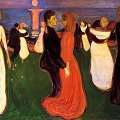 The turn of the century was a
phase of restless experimentation. A more colourful and decorative
style manifests itself, influenced by the art of the Nabis,
particularly Maurice Denis. As early as 1899 Munch painted "The Dance
of Life", which can be interpreted as a daring and personal
monumentalization of this decorative flat style.
The turn of the century was a
phase of restless experimentation. A more colourful and decorative
style manifests itself, influenced by the art of the Nabis,
particularly Maurice Denis. As early as 1899 Munch painted "The Dance
of Life", which can be interpreted as a daring and personal
monumentalization of this decorative flat style.
A series of landscape paintings from the Kristiania fjord, decorative and sensitive studies of nature, are regarded as highlights in Nordic symbolism. The classic and evocative "Girls on the Bridge" was painted in Asgardstrand the summer of 1901.
Success and crisis
In the early years of the new century Munch was in the process of firmly establishing his career. In 1902 he showed the entire Frieze for the first time at the Secession exhibition in Berlin. An exhibition in Prague in 1905 had an impact on several Czech artists. Portraits, usually full-length, gradually constituted an important part of his oeuvre. The group portrait of Dr. Linde's sons (1904) is reckoned to be one of the masterpieces of modern portraiture.
The Fauvists, led by Matisse, shared many of Munch's new artistic approaches. The "Die Brucke" group in Dresden was interested in Munch, but they did not succeed in getting him to show his paintings at their exhibitions.
Artistic success was accompanied by personal conflicts. Alcohol had become a problem, and Munch was emotionally unstable. He was plagued by the memories of his tragic love affair, which had come to a dramatic end with a revolver scene in Asgardstrand in the autumn of 1902, permanently injuring a finger on Munch's left hand. He nevergot over the ignominy of this incident, but during these years it became an obsession. The woman's features can be seen in "Death of Marat" (two versions from 1907), a motif which more generally can be said to portray "the battle called love between men and women."
 Henrik Ibsen
died in May 1906, and in the autumn Munch made the set designs for Max
Reinhardt's production of "Ghosts" at the new intimate stage at
Deutsches Theater in Berlin. Ibsen assumed an increasingly more
important place in Munch's consciousness. "Self-portrait with Bottle
of Wine" from 1906 shows a powerless, hunched over figure sitting
alone at a table in a claustrophobic cafe interior - a tragic sight
spiritually related to Osvald in Ibsen's drama.
Henrik Ibsen
died in May 1906, and in the autumn Munch made the set designs for Max
Reinhardt's production of "Ghosts" at the new intimate stage at
Deutsches Theater in Berlin. Ibsen assumed an increasingly more
important place in Munch's consciousness. "Self-portrait with Bottle
of Wine" from 1906 shows a powerless, hunched over figure sitting
alone at a table in a claustrophobic cafe interior - a tragic sight
spiritually related to Osvald in Ibsen's drama.
On commission Munch did a monumental fantasy portrait of Freidrich Nietzsche, and during several visits in Weimar he also did a portrait of the late philosopher's sister, Elisabeth Forster-Nietzsche.
New motifs from this period show signs of a more extroverted orientation. "Bathing Men" (1907-08) is a vigorous tribute to vital manliness. However, his alcohol and mental problems reached a critical point, and Munch decided to spend eight months at a clinic in Copenhagen. Norway finally opened its eyes to his artistic talent, and he was awarded the Order of St. Olav during his stay at the clinic.
Back in Norway
From 1909 and for the rest of his life Munch resided in Norway. At first he settled down in Kragero, a coastal town farther south. Here he painted several classic winter landscapes and threw himself enthusiastically into the competition for the decoration of the University of Kristiania's new auditorium, the Aula.
In 1912, Munch was given a prominent place among pioneers of modern art at the large Sonderbund exhibition in Cologne.
In Kragero he built large outdoor studios where he worked for several years on the designs for Aula. After prolonged controversy Munch's designs were finally accepted and installed in the auditorium in 1916.
According to Munch himself, the motifs in the Aula celebrate the "perpetual forces of life." The background motif shows a sunrise over the fjord, based on the view from the property Munch rented in Kragero. The explosive composition may also be viewed as a symbol of the boundless and life-giving power of light. The large canvases "History" and "Alma Mater" hang like pendants in the Aula: an old man is sitting under a great oak tree in a meagre and rugged landscape relating the saga of mankind to a little boy, and in a gentle and verdant landscape a woman is sitting on a seashore with a child at her breast, while bigger children are exploring the surroundings. Besides alluding to the humanities and sciences, the two "archetypal" motifs are expressions of a male and female principle, a central opposition in Munch's visual world.
Munch showed an interest in the growing Labour Movement in several motifs from this time, some of them monumental in character. "Workers on Their Way Home" (1913-15) is also a dynamic study of perspective and movement.
In 1916 Munch purchased the property Ekely outside Kristiania (renamed Oslo in 1924). Landscapes, people in harmony with nature, horses and ploughing - these were the motifs which were now portrayed in strong, clear colours. Through fresh and spontaneous brushwork he conveys a rough and sensuous tribute to sun, air and the earth.
At Ekely Munch lived to a steadily greater degree in self-chosen isolation, spartan, surrounded only by his pictures. He was constantly productive, but parted only reluctantly with "his children." Arrangements were made to lend the pictures to a number of international exhibitions.
In his later years Munch painted a number of studies and compositions using a model. Some of these have a vigorous and life-embracing quality, while in others he continued to explore the conflict-filled themes of the 1890s. He continued to produce a considerable number of graphics, including a number of lithographic portraits.
Before Munch died in January 1944, he had willed his large collection of pictures and uncatalogued biographical and literary notes to the City of Oslo. Consequently, the Munch Museum, dedicated in 1963, has a unique collection of Munch's art and other material which illuminates all phases of the artistic process.
The National Gallery in Oslo also has an exquisite Munch collection particularly rich in main, early paintings. Major works are also found in the Bergen Art Gallery.
© F. H.
Edvard Munch Art
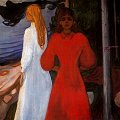
|
|
More
Articles
 Art Encyclopedia A world history of art in articles.
Art Encyclopedia A world history of art in articles.
Modernism
Edvard Munch
Art, life, and world of symbolic expression.
Art, paintings, and works.
The Scream.
Art
 Art Wallpapers Art image collections for your desktop.
Art Wallpapers Art image collections for your desktop.
Munch Art, $19
(75 pictures)
Malevich Art, $25
(105 pictures)
Modigliani Art, $29
(135 pictures)
Klee Art, $25
(150 pictures)
Miro Art, $35
(150 pictures)
Matisse Art, $29
(180 pictures)
Picasso Art, $29
(175 pictures)
Dali Art, $35
(275 pictures)
Chagall Art, $35
(175 pictures)

